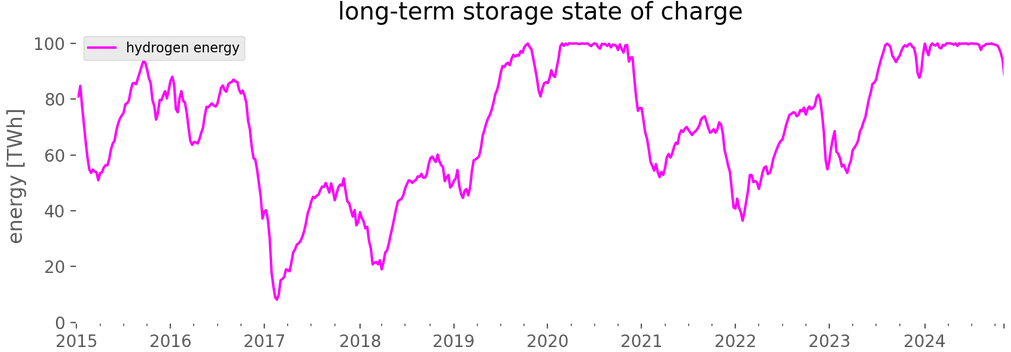Tough few days for our simulation of a future German renewable electricity system.
-
Tough few days for our simulation of a future German renewable electricity system. The dreaded dark wind lull forces the model to rely on stored electrolytic hydrogen. But fortunately hydrogen storage was full at the beginning, and has only dropped to a level of 85% so far.
-
What would alternative clean supply systems look like?
Imports: The model treats Germany as an island, which is daft given how well Germany is interconnected today. Imports would help to substitute some hydrogen with electricity generation from regions with a bit more wind during these days.
-
Batteries: Batteries are in the model (grey) but can only shift solar peaks by a few hours. No help against this multi-day event.
Non-hydrogen long-duration energy storage (LDES): Electrochemical options with e.g. 100 hours of storage could help, but note this event could go on for another week.
Demand response: Some industrial consumers could shut down for several days with the right incentives, but other consumers would struggle with multiple days.
-
Other green molecules: Hydrogen is a pain to handle, but other green-hydrogen-based molecules could substitute, like methane, methanol or ammonia, see e.g. here: https://nworbmot.org/energy/brown-iew24.pdf
-
Nuclear: Nuclear is not great for capacity because of its high CAPEX. Suppose we built 70 GW of nuclear. Then it has to fight with wind and solar at other times, and it won't compete in long-run unless it has LCOE < 80 EUR/MWh (rough system cost of this renewables-based system with interconnection).
-
Biomass residues: Plants that use solid biomass have high CAPEX because of need to handle inhomogeneous feedstock. Biogas plants are too small to store enough biogas for rare events like this. Can upgrade biomass to biomethane/ol and store it centrally. But then the usage of sustainable carbon competes w/ industry feedstocks, dense fuels and CDR.
-
Unabated fossil fuels compensated by carbon dioxide removal (CDR): Could be cost-effective in the long-run, but many challenges: we should be keeping CDR for harder-to-abate sectors, upstream emissions have to be compensated, other air pollutants are released (NOx etc).
-
Fossil fuels with carbon capture and sequestration (CCS): Can be cost-effective, but some solutions have high CAPEX (others like Allam cycle maybe do not), sequestration capacity is initially scarce and taken by harder-to-abate sectors, upstream emissions, air pollutants (again, doesn't apply to Allam).
Any more suggestions?
-
@nworbmot the latest thing I heard that I previously hadn't on my LDES bingo card is sulfur. @DLR is running a research project. https://www.dlr.de/en/latest/news/2021/04/20211209_solar-energy-storage-using-sulphur https://www.pegasus-project.eu/


